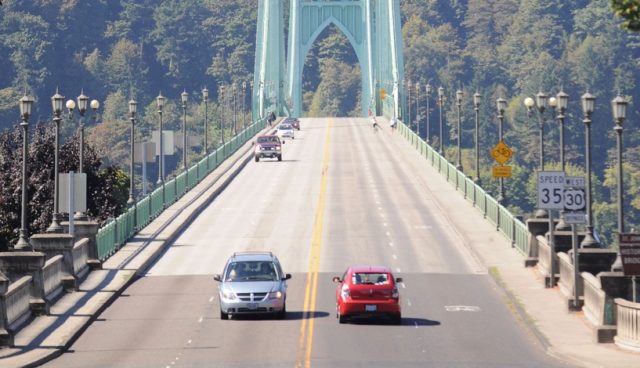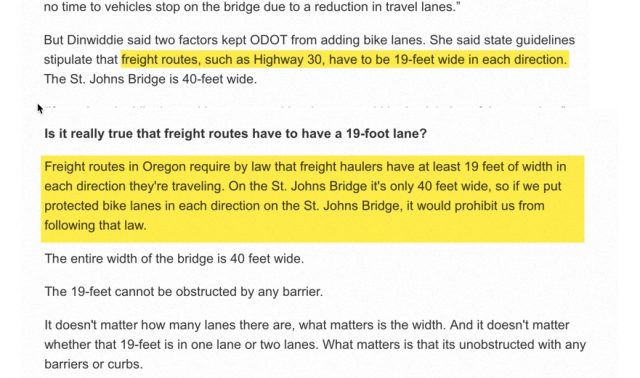
(Photo: Joe Mabel/Wikipedia)
Despite multiple demands over the years to improve bike access on the St. Johns Bridge, the Oregon Department of Transportation has used many different excuses for why the current lane configuration simply cannot change. And it turns out their latest excuse — that state design guidelines for freight traffic require 19-foot wide lanes in both directions — is untrue.
ODOT is facing renewed pressure to make the bridge safer for cycling after 55-year-old Mitch York was killed while biking on the bridge on October 29th.
The claim about lane width first raised eyebrows on October 31st when ODOT spokesperson Kimberley Dinwiddie told KGW News that state law mandated 19-feet of width. We immediately questioned the figure in a Twitter post and a KGW reporter then followed-up with Dinwiddie in an effort to clarify the information.
In a Q & A posted as an update to the original KGW story, Dinwiddie repeated the claim…

Advertisement
I checked both the relevant Oregon law (ORS 366.215) and the Oregon Administrative Rule that implements that law and found no reference to 19-feet, so I also asked Dinwiddie to clarify the statement. On November 2nd she reiterated the claim she made to KGW. The 19-foot lane width is, “a guideline we use statewide to make sure freight can move over a variety of different kinds of highways and bridges,” she said via email. When I followed up again two days later to ask whether or not it applied to both directions (meaning they’d need 38-feet of width for freight), ODOT’s Public Information Coordinator David Thompson also mentioned the 19-foot guideline. Thompson then said he’d check with ODOT’s Motor Carrier Division just to make sure precisely when the 19-feet stipulation applies.
As promised, yesterday I heard back from ODOT Region 1 spokesperson Don Hamilton who met with the agency’s freight experts in Salem. Hamilton said the 19-foot guideline applies only during construction. “In our earlier communications with you, we misunderstood this guideline,” Hamilton said. “Our apologies.”
So, just to be clear, ODOT does not need to preserve 19-foot lanes in each direction on the St. Johns Bridge.
The other excuse they gave KGW for why there’s no room to improve bicycle access on the main bridge roadway was, “because of the congestion and dangerous situations that could occur from that.” That claim also doesn’t quite match up with the facts and deserves much more scrutiny.
In fact, the more I learn about this issue, the more it seems like ODOT doesn’t have any legitimate excuse for not considering design changes on the St. Johns Bridge; changes that could vastly improve safety for all users. So why aren’t they more open to ideas? That’s a good question.
Stay tuned.
— Jonathan Maus, (503) 706-8804 – jonathan@bikeportland.org
BikePortland is supported by the community (that means you!). Please become a subscriber or make a donation today.

